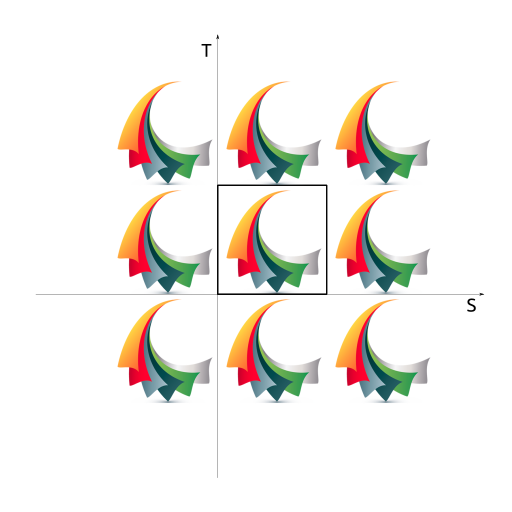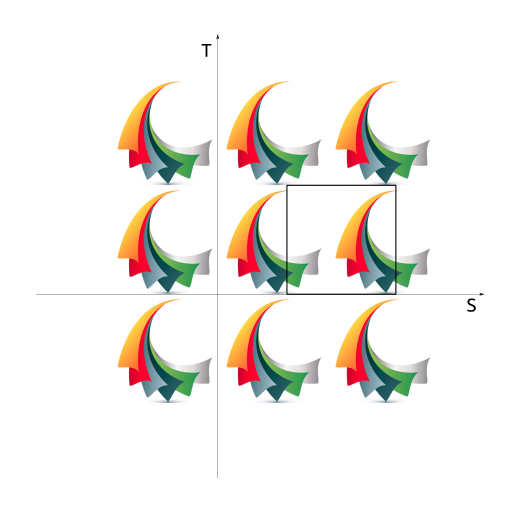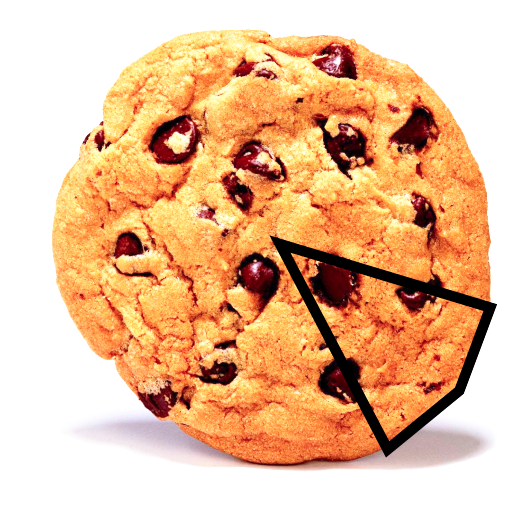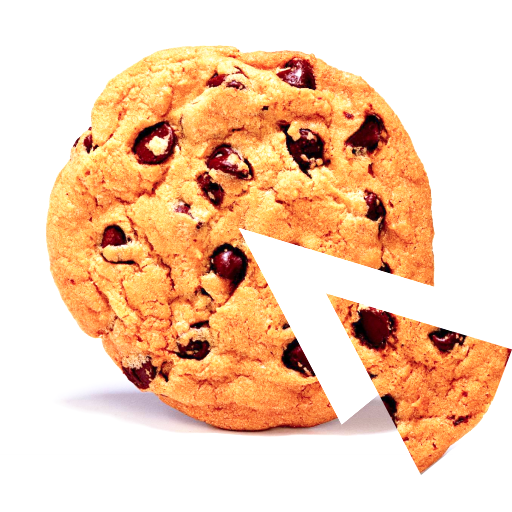Controlling How Textures are Mapped
Motivation
- By default, an entire texture image is mapped once around the shape
- You can also:
- Extract only pieces of interest
- Create repeating patterns
Working through the texturing process
- Imagine the texture image is a big piece of rubbery cookie dough
- Select a texture image piece
- Define the shape of a cookie cutter
- Position and orient the cookie cutter
- Stamp out a piece of texture dough
- Stretch the rubbery texture cookie to fit a face
Using texture coordinate system
Texture images (the dough) are in a texture coordinate system:
- S - direction is horizontal
- T - direction is vertical
- (0,0) at lower-left
- (1,1) at upper-right
Specifying texture coordinates
Texture coordinates and texture coordinate indexes specify a texture piece shape (the cookie cutter):
Applying texture transforms
Texture transforms translate, rotate, and scale the texture coordinates (placing the cookie cutter):
Texturing a face
Bind the texture to a face (stretch the cookie and stick it):
Working through the texturing process
- Select piece with texture coordinates and indexes
- Create a cookie cutter
- Transform the texture coordinates
- Position and orient the cookie cutter
- Bind the texture to a face
- Stamp out the texture and stick it on a face
- The process is very similar to creating faces!
Syntax: TextureCoordinate
A TextureCoordinate node contains a list of texture coordinates:
XML Encoding
1
2
<TextureCoordinate
point='0.2 0.2, 0.8 0.2, ...'/>
Classic VRML Encoding
1
2
3
TextureCoordinate {
point [ 0.2 0.2, 0.8 0.2, ... ]
}
Used as the texCoord field value of IndexedFaceSet or ElevationGrid nodes.
Syntax: IndexedFaceSet
An IndexedFaceSet geometry node creates geometry out of faces:
- texCoord and texCoordIndex - specify texture pieces
XML Encoding
1
2
3
4
5
6
7
8
9
<Shape>
<Appearance><!-- ... --></Appearance>
<IndexedFaceSet
texCoordIndex='...'
coordIndex='...'>
<TextureCoordinate ... />
<Coordinate ... />
</IndexedFaceSet>
</Shape>
Classic VRML Encoding
1
2
3
4
5
6
7
8
9
Shape {
appearance Appearance { ... }
geometry IndexedFaceSet {
texCoordIndex [ ... ]
coordIndex [ ... ]
texCoord TextureCoordinate { ... }
coord Coordinate { ... }
}
}
Syntax: ElevationGrid
An ElevationGrid geometry node creates terrains:
- texCoord - specify texture pieces
- Automatically generated texture coordinate indexes
XML Encoding
1
2
3
4
5
6
7
<Shape>
<Appearance><!-- ... --></Appearance>
<ElevationGrid
height='...'>
<TextureCoordinate ... />
</ElevationGrid>
</Shape>
Classic VRML Encoding
1
2
3
4
5
6
7
Shape {
appearance Appearance { ... }
geometry ElevationGrid {
texCoord TextureCoordinate { ... }
height [ ... ]
}
}
Syntax: Appearance
An Appearance node describes overall shape appearance:
- textureTransform - transform
XML Encoding
1
2
3
4
5
6
7
8
<Shape>
<Appearance>
<Material ... />
<ImageTexture ... />
<TextureTransform ... />
</Appearance>
<!-- geometry ... -->
</Shape>
Classic VRML Encoding
1
2
3
4
5
6
7
8
Shape {
appearance Appearance {
material Material { ... }
texture ImageTexture { ... }
textureTransform TextureTransform { ... }
}
geometry ...
}
Syntax: TextureTransform
A TextureTransform node transforms texture coordinates:
- translation - position
- rotation - orientation
- scale - size
XML Encoding
1
2
3
4
5
6
7
8
9
10
11
<Shape>
<Appearance>
<Material ... />
<ImageTexture ... />
<TextureTransform
translation='0.0 0.0'
rotation='0.0'
scale='1.0 1.0'/>
</Appearance>
<!-- geometry ... -->
</Shape>
Classic VRML Encoding
1
2
3
4
5
6
7
8
9
10
11
12
Shape {
appearance Appearance {
material Material { ... }
texture ImageTexture { ... }
textureTransform TextureTransform {
translation 0.0 0.0
rotation 0.0
scale 1.0 1.0
}
}
geometry ...
}
Scaling, rotating, and translating
Scale, Rotate, and Translate a texture cookie cutter one after the other:
XML Encoding
1
2
3
4
5
6
7
8
9
10
11
<Shape>
<Appearance>
<Material ... />
<ImageTexture ... />
<TextureTransform
translation='0.0 0.0'
rotation='0.785'
scale='8.5 8.5'/>
</Appearance>
<!-- geometry ... -->
</Shape>
Classic VRML Encoding
1
2
3
4
5
6
7
8
9
10
11
12
Shape {
appearance Appearance {
material Material { ... }
texture ImageTexture { ... }
textureTransform TextureTransform {
translation 0.0 0.0
rotation 0.785
scale 8.5 8.5
}
}
geometry ...
}
Read texture transform operations top-down:
- The cookie cutter is translated, rotated, then scaled Order is fixed, independent of field order
- This is the reverse of a Transform node
Summary
- Texture images are in a texture coordinate system
- Texture coordinates and indexes describe a texture cookie cutter
- Texture transforms translate, rotate, and scale place the cookie cutter
- Texture indexes bind the cut-out cookie texture to a face on a shape




